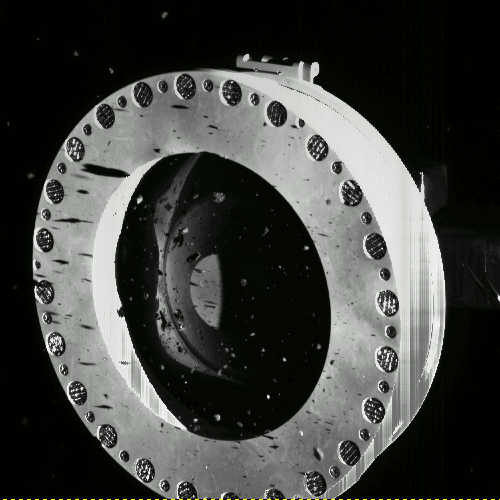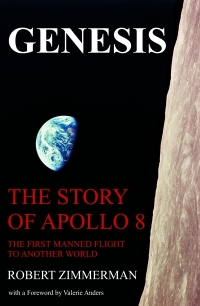OSIRIS-REx sample grab so successful they are losing material

Click for full two frame gif movie.
In a briefing today and press release, the OSIRIS-REx science team announced that they estimate that they have gathered a lot of material from the asteroid Bennu, at least 100s of grams, about twice the minimum of what they hoped to get.
In fact, images of the TAGSAM sample grab equipment suggest that there are some larger rocks lodged in its opening (preventing the flap from closing), and that the small movements they have done to photograph it has caused some of the captured material to escape. The image to the right shows this. You can see floating specks and their shadows (the horizontal streaks) that have escaped. At about 9 o’clock you can see a curve in the contact between a lighter material and blackness to its outside, bending towards the center of the TAGSAM. At other exposures they can clearly see a rock there, distorting the shape and thus preventing the flap from closing properly.
Because of this, they are foregoing the spin maneuver that would have weighed the sample, as well as one engine burst that would have slowed the spacecraft’s movement away from Bennu.
This means they will not know the exact amount captured until the sample gets back to Earth. This is a gamble, but they are confident that they have gotten a lot of material. According to Dante Lauretta, the principal investigator, the sample grab-and-go “got very down” into Bennu, as much as 19 inches. He is also confident that they grabbed more than a 100 grams.
They are therefore going to as quickly as possible store the samples in the Sample Return Capsule for return to Earth, beginning on October 27. They need to do a complex series of steps to make this happen, which is why it cannot happen until then.
One more detail: In their simulations prior to the touch-and-go, they had a range of estimates of how deep the spacecraft would penetrate. According to Lauretta, OSIRIS-REx plunged into Bennu at the softest part of that range, telling them that the asteroid is probably much more loosely packed than expected.
Because they are not doing that last engine burst means that they are moving away from Bennu for good. They will not return to the asteroid. Whether they will be able to get post sample grab images of Nightingale is unknown.
On Christmas Eve 1968 three Americans became the first humans to visit another world. What they did to celebrate was unexpected and profound, and will be remembered throughout all human history. Genesis: the Story of Apollo 8, Robert Zimmerman's classic history of humanity's first journey to another world, tells that story, and it is now available as both an ebook and an audiobook, both with a foreword by Valerie Anders and a new introduction by Robert Zimmerman.
The print edition can be purchased at Amazon or from any other book seller. If you want an autographed copy the price is $60 for the hardback and $45 for the paperback, plus $8 shipping for each. Go here for purchasing details. The ebook is available everywhere for $5.99 (before discount) at amazon, or direct from my ebook publisher, ebookit. If you buy it from ebookit you don't support the big tech companies and the author gets a bigger cut much sooner.
The audiobook is also available at all these vendors, and is also free with a 30-day trial membership to Audible.
"Not simply about one mission, [Genesis] is also the history of America's quest for the moon... Zimmerman has done a masterful job of tying disparate events together into a solid account of one of America's greatest human triumphs."--San Antonio Express-News

Click for full two frame gif movie.
In a briefing today and press release, the OSIRIS-REx science team announced that they estimate that they have gathered a lot of material from the asteroid Bennu, at least 100s of grams, about twice the minimum of what they hoped to get.
In fact, images of the TAGSAM sample grab equipment suggest that there are some larger rocks lodged in its opening (preventing the flap from closing), and that the small movements they have done to photograph it has caused some of the captured material to escape. The image to the right shows this. You can see floating specks and their shadows (the horizontal streaks) that have escaped. At about 9 o’clock you can see a curve in the contact between a lighter material and blackness to its outside, bending towards the center of the TAGSAM. At other exposures they can clearly see a rock there, distorting the shape and thus preventing the flap from closing properly.
Because of this, they are foregoing the spin maneuver that would have weighed the sample, as well as one engine burst that would have slowed the spacecraft’s movement away from Bennu.
This means they will not know the exact amount captured until the sample gets back to Earth. This is a gamble, but they are confident that they have gotten a lot of material. According to Dante Lauretta, the principal investigator, the sample grab-and-go “got very down” into Bennu, as much as 19 inches. He is also confident that they grabbed more than a 100 grams.
They are therefore going to as quickly as possible store the samples in the Sample Return Capsule for return to Earth, beginning on October 27. They need to do a complex series of steps to make this happen, which is why it cannot happen until then.
One more detail: In their simulations prior to the touch-and-go, they had a range of estimates of how deep the spacecraft would penetrate. According to Lauretta, OSIRIS-REx plunged into Bennu at the softest part of that range, telling them that the asteroid is probably much more loosely packed than expected.
Because they are not doing that last engine burst means that they are moving away from Bennu for good. They will not return to the asteroid. Whether they will be able to get post sample grab images of Nightingale is unknown.
On Christmas Eve 1968 three Americans became the first humans to visit another world. What they did to celebrate was unexpected and profound, and will be remembered throughout all human history. Genesis: the Story of Apollo 8, Robert Zimmerman's classic history of humanity's first journey to another world, tells that story, and it is now available as both an ebook and an audiobook, both with a foreword by Valerie Anders and a new introduction by Robert Zimmerman.
The print edition can be purchased at Amazon or from any other book seller. If you want an autographed copy the price is $60 for the hardback and $45 for the paperback, plus $8 shipping for each. Go here for purchasing details. The ebook is available everywhere for $5.99 (before discount) at amazon, or direct from my ebook publisher, ebookit. If you buy it from ebookit you don't support the big tech companies and the author gets a bigger cut much sooner.
The audiobook is also available at all these vendors, and is also free with a 30-day trial membership to Audible.
"Not simply about one mission, [Genesis] is also the history of America's quest for the moon... Zimmerman has done a masterful job of tying disparate events together into a solid account of one of America's greatest human triumphs."--San Antonio Express-News


Mr. Z.,
->grams transformed into ounces between the 1st and 4th paragraph;
‘He is also confident that they grabbed more than a 100 ounces.’
wayne: Fixed. Thank you.
Mr. Z.–
How large is the device in the picture?
Excavator Lessons
Gold Rush
https://youtu.be/fjqhy4NRAqM
1:56
Wayne: See: https://www.asteroidmission.org/?attachment_id=1699
thank you!
Geologists always talk about how important the context of a sample is. That’s why meteorites have limited potential for them, because they have no idea of how they got here. But Bennu being a conglomerate of asteroids, I wonder how useful this sample will be. It seems to likely be a random collection of general asteroid dust and gravel without knowledge of where and when.
It seems to me that if the sample arm went that deep into the asteroid, it is less a solid body than a closely-packed formation of debris. That in itself is interesting, but I cannot think of any terrestrial material in which that level of force would produce those results.
As to the sample and what it will mean:
We already knew that the reflectance spectra for Bennu, as well as 75% of all Belt asteroids, matched well with what we call Carbonaceous Chondrite meteorites. These are 5-18% water, 15-39% carbonaceous kerogen materials, and highly variable amounts of native Nickel/Iron bits, along with light metal oxides and silicates. The primary question for space miners is, “how close do they get to the Sun before their volatile portions are heated into gas and driven away”, since water, with its Hydrogen content, is considered to be a major desirable target for mining in the first few decades of any such endeavor.
We can also examine their spin/tumble rate in telescopes, and we find that most with that reflectance spectrum have a startlingly *low* rate of spin/tumble. For decades, the most widely held interpretation of that has been that these are loosely agglomerated bodies that cannot hold together at spin rates much higher than what we see for them. The only question was where in the range of “loose” each body is. Bennu, it should be noted, is just a *single* data point for such studies, but it *is* encouraging for miners.
That is because the capital costs for physically removing material from such a body are *far* lower than they would be for a body that has had its material melted and then cooled into a solidified mass, no matter what materials it contains. This assumes, of course that few, if any, asteroid bodies will ever be “towed” back to Earth orbit. Then we are looking at capital costs orders of magnitude greater than for “out and back” expeditions moving a few hundred tons at a time. Loosely agglomerated bodies would be much more difficult to move, requiring the whole mass be “bagged”, so that even as it slumps from acceleration, the bag holds it together while it is “despun” from its tumble, and set on a course for an Earth.Moon libration point like EML-1.